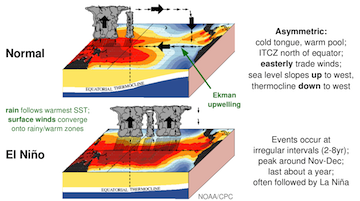371015-tranquil spring.png

Comparison of normal and El Niño conditions, for the tropical Pacific region in December through February. Credit: National Oceanic and Atmospheric Administration
For much of the United States, El Niño is a welcome event. It tends to bring more moderate temperatures to most of the country, and more rainfall to parts of the southwest. It also reduces the number and intensity of tropical storms that hit our coastline. And recent research suggests another benefit: fewer tornadoes and big hail storms across most of the country.
El Niño occurs every few years, when the surface of the eastern Pacific Ocean gets warmer than average. More water evaporates and streams across the U.S., altering weather patterns over millions of square miles.
One of those changes is in the jet streams. The jet stream over the Gulf of Mexico tends to get stronger, while the one over the continent gets weaker. That prevents Gulf moisture from streaming northward. The combination of less moisture and a weaker jet stream subdues the conditions that spawn violent weather. So according to the study, the risk of violent weather is much lower during El Niño.
The same study also found that the risk is much higher during La Niña. That’s the opposite of El Niño, when the water temperatures in the eastern Pacific are cooler than normal. La Niña tends to cause more-extreme temperatures, drought conditions across the southwest, and more tropical storms.
If there are El Niño or La Niña conditions over the winter, they generally stick around for spring -- the stormiest season. That could help officials predict a stormy spring during La Niña -- or chill to a calmer season during El Niño.

